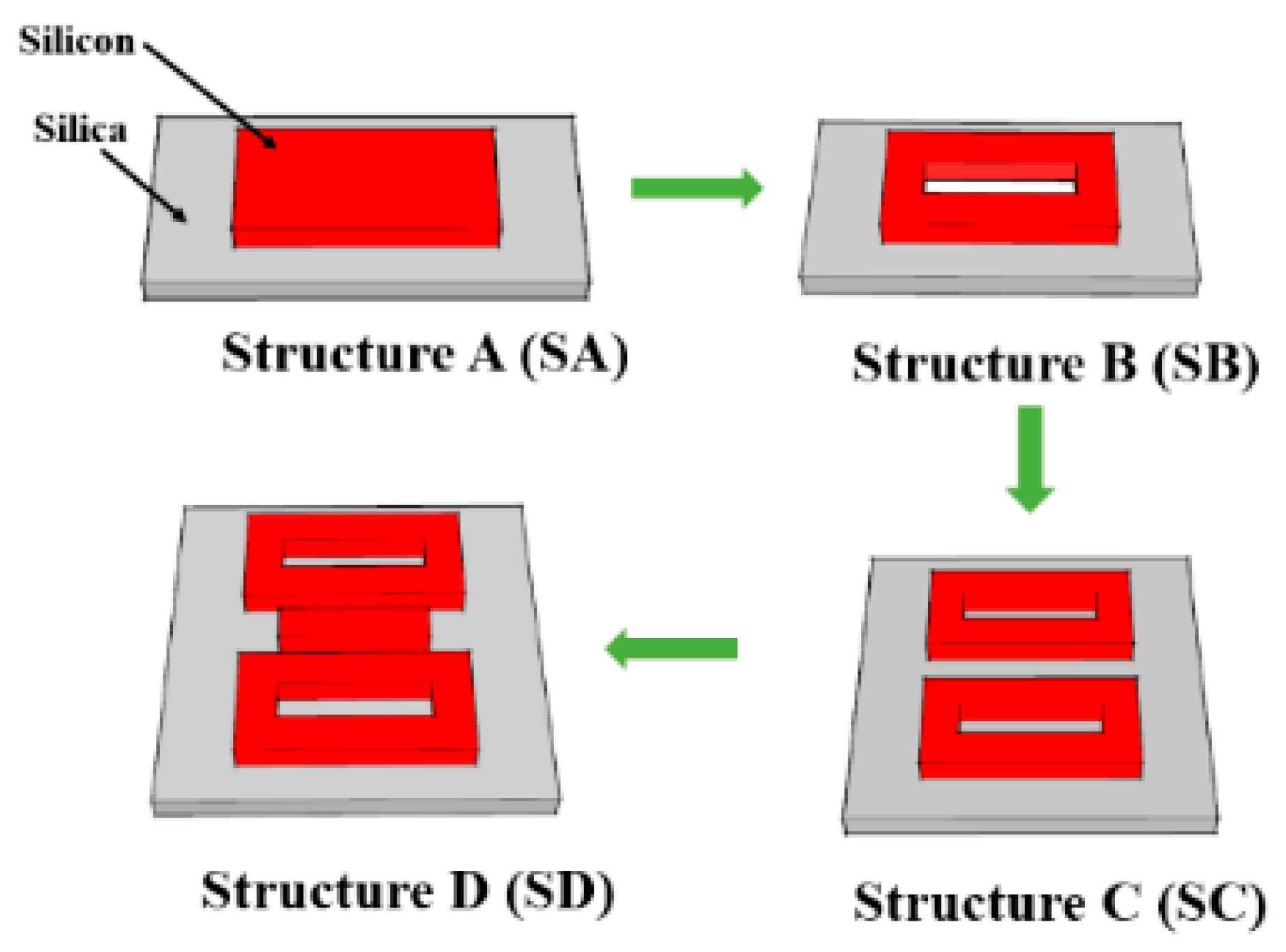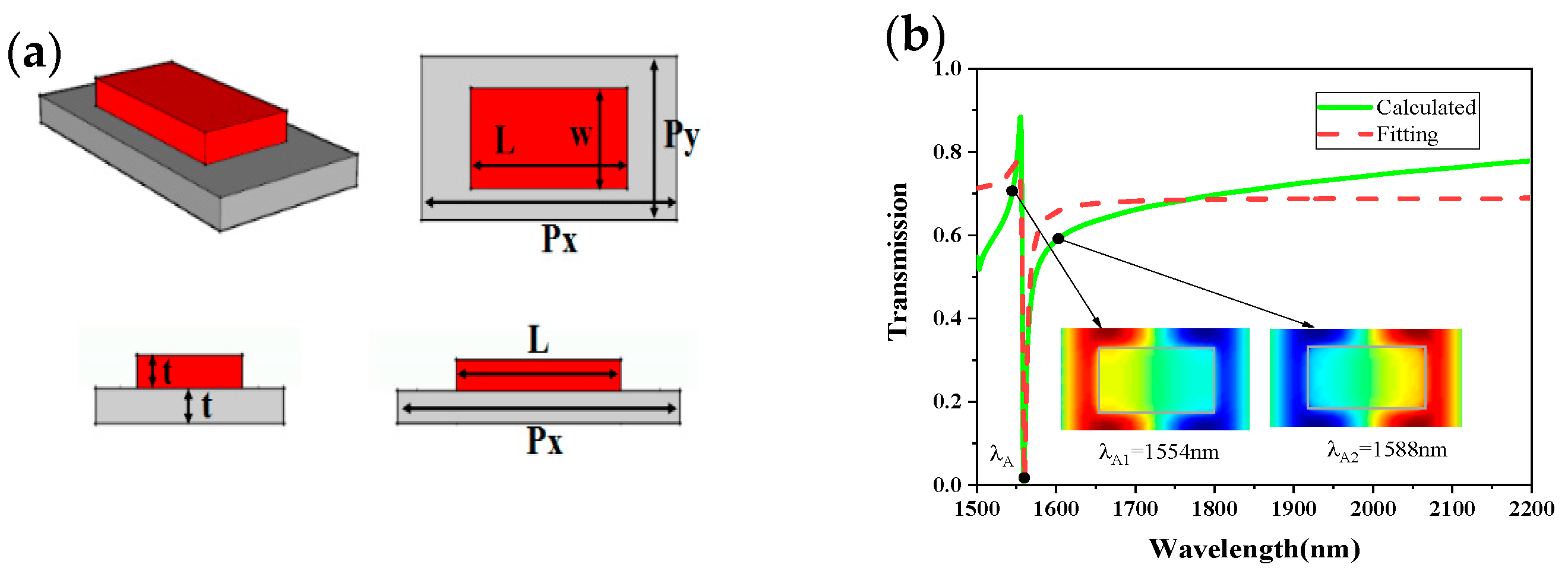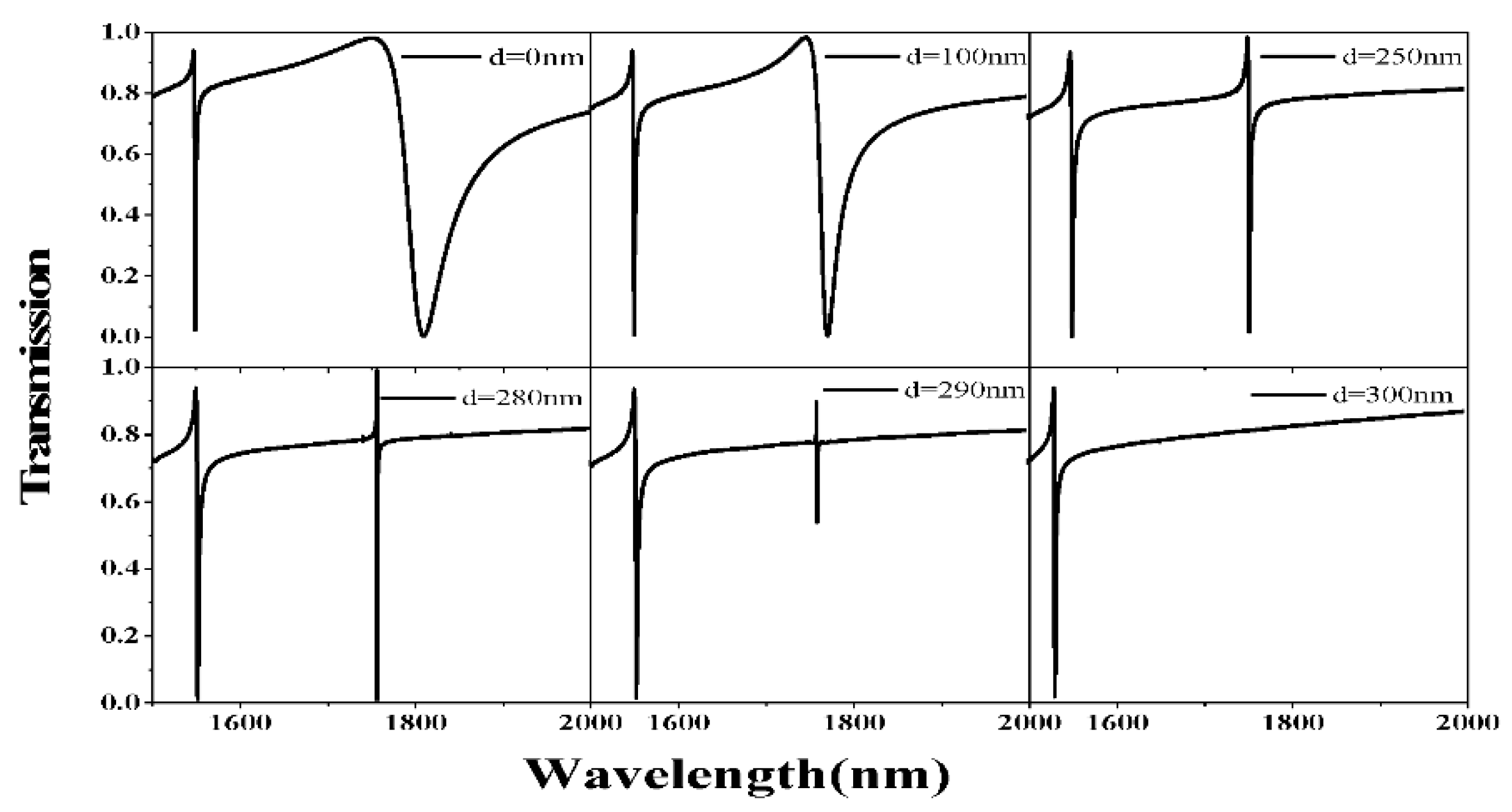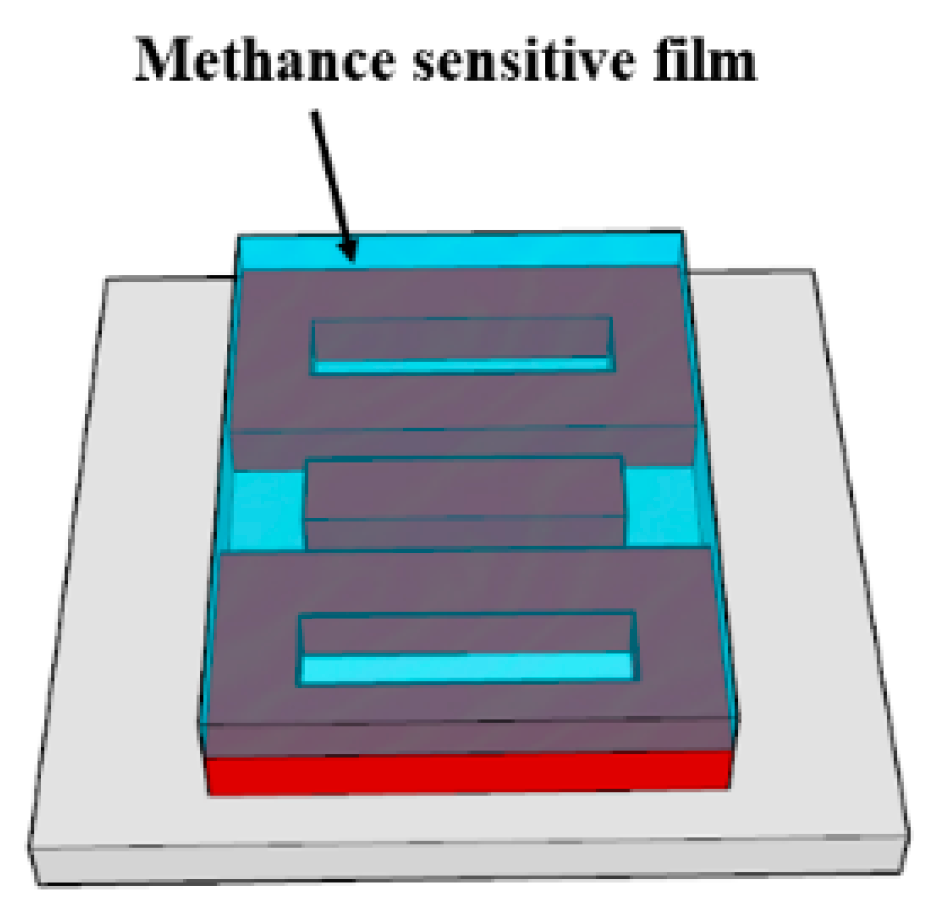Simultaneous Measurements of Refractive Index and Methane Concentration through Electromagnetic Fano Resonance Coupling in All-Dielectric Metasurface
Abstract
1. Introduction
2. Design and Simulation
3. Measurement and Analysis
4. Conclusions
Funding
Data Availability Statement
Conflicts of Interest
References
- Limonov, M.F.; Rybin, M.V.; Poddubny, A.N.; Kivshar, Y.S. Fano resonances in photonics. Nat. Photonics 2017, 11, 543–554. [Google Scholar] [CrossRef]
- Miroshnichenko, A.E.; Flach, S.; Kivshar, Y.S. Fano resonances in nanoscale structures. Rev. Mod. Phys. 2010, 82, 2257–2298. [Google Scholar] [CrossRef]
- Nguyen, V.A.; Ngo, Q.M.; Le, K.Q. Efficient Color Filters Based on Fano-Like Guided-Mode Resonances in Photonic Crystal Slabs. IEEE Photonics J. 2018, 10. [Google Scholar] [CrossRef]
- Alipour, A.; Mir, A.; Farmani, A. Ultra high-sensitivity and tunable dual-band perfect absorber as a plasmonic sensor. Opt. Laser Technol. 2020, 127, 106201. [Google Scholar] [CrossRef]
- Li, R.; Mao, H.; Zhu, M.; Yang, Y.; Xiong, J.; Wang, W. Facile preparation of broadband absorbers based on patternable candle soot for applications of optical sensors. Sensors Actuators A Phys. 2019, 285, 111–117. [Google Scholar] [CrossRef]
- Tittl, A.; Leitis, A.; Liu, M.; Yesilkoy, F.; Choi, D.Y.; Neshev, D.N.; Kivshar, Y.S.; Altug, H. Imaging-based molecular barcoding with pixelated dielectric metasurfaces. Science 2018, 360, 1105–1109. [Google Scholar] [CrossRef] [PubMed]
- Chen, X.; Tao, Z.; Chen, C.; Wang, C.; Wang, L.; Jiang, H.; Fan, D.; Ekinci, Y.; Liu, S. All-dielectric metasurface-based roll-angle sensor. Sensors Actuators, A Phys. 2018, 279, 509–517. [Google Scholar] [CrossRef]
- He, Z.; Xue, W.; Cui, W.; Li, C.; Li, Z.; Pu, L.; Feng, J.; Xiao, X.; Wang, X.; Li, G. Tunable fano resonance and enhanced sensing in a simple Au/TiO2 hybrid metasurface. Nanomaterials 2020, 10, 687. [Google Scholar] [CrossRef]
- Su, W.; Geng, Z.; Qi, J.; Wu, H. Multi-fano resonances in graphene coated all-dielectric metasurface for refractive index sensing with high figure of merits. IEEE J. Sel. Top. Quantum Electron. 2021, 27, 1–6. [Google Scholar] [CrossRef]
- Singh, R.; Cao, W.; Al-Naib, I.; Cong, L.; Withayachumnankul, W.; Zhang, W. Ultrasensitive terahertz sensing with high- Q Fano resonances in metasurfaces. Appl. Phys. Lett. 2014, 105, 1–5. [Google Scholar] [CrossRef]
- Yang, Y.; Kravchenko, I.I.; Briggs, D.P.; Valentine, J. All-dielectric metasurface analogue of electromagnetically induced transparency. Nat. Commun. 2014, 5, 1–7. [Google Scholar] [CrossRef]
- Liu, G.D.; Zhai, X.; Wang, L.L.; Lin, Q.; Xia, S.X.; Luo, X.; Zhao, C.J. A High-Performance Refractive Index Sensor Based on Fano Resonance in Si Split-Ring Metasurface. Plasmonics 2018, 13, 15–19. [Google Scholar] [CrossRef]
- Ahmadivand, A.; Karabiyik, M.; Pala, N. Inducing multiple Fano resonant modes in split concentric nanoring resonator dimers for ultraprecise sensing. J. Opt. 2015, 17, 85104. [Google Scholar] [CrossRef]
- Yesilkoy, F.; Arvelo, E.R.; Jahani, Y.; Liu, M.; Tittl, A.; Cevher, V.; Kivshar, Y.; Altug, H. Ultrasensitive hyperspectral imaging and biodetection enabled by dielectric metasurfaces. Nat. Photonics 2019, 13, 390–396. [Google Scholar] [CrossRef]
- Chung, T.; Lee, S.Y.; Song, E.Y.; Chun, H.; Lee, B. Plasmonic nanostructures for nano-scale bio-sensing. Sensors 2011, 11, 10907–10929. [Google Scholar] [CrossRef]
- La Spada, L. Metasurfaces for advanced sensing and diagnostics. Sensors 2019, 19, 355. [Google Scholar] [CrossRef]
- Lee, Y.; Kim, S.J.; Park, H.; Lee, B. Metamaterials and metasurfaces for sensor applications. Sensors 2017, 17, 1726. [Google Scholar] [CrossRef]
- Leitis, A.; Tittl, A.; Liu, M.; Lee, B.H.; Gu, M.B.; Kivshar, Y.S.; Altug, H. Angle-multiplexed all-dielectric metasurfaces for broadband molecular fingerprint retrieval. Sci. Adv. 2019, 5, 1–9. [Google Scholar] [CrossRef]
- Patel, S.K.; Parmar, J.; Kosta, Y.P.; Ladumor, M.; Zakaria, R.; Nguyen, T.K.; Dhasarathan, V. Design of graphene metasurface based sensitive infrared biosensor. Sens. Actuators A Phys. 2020, 301, 111767. [Google Scholar] [CrossRef]
- Tang, Y.; Zhang, Z.; Wang, R.; Hai, Z.; Xue, C.; Zhang, W.; Yan, S. Refractive index sensor based on fano resonances in metal-insulator-metal waveguides coupled with resonators. Sensors 2017, 17, 784. [Google Scholar] [CrossRef]
- Allsop, T.; Arif, R.; Neal, R.; Kalli, K.; Kundrát, V.; Rozhin, A.; Culverhouse, P.; Webb, D.J. Photonic gas sensors exploiting directly the optical properties of hybrid carbon nanotube localized surface plasmon structures. Light Sci. Appl. 2016, 5. [Google Scholar] [CrossRef] [PubMed]
- Chen, C.Y.; Hsiao, P.H. Position-dependent sensing performance of coupled resonators with symmetry breaking. J. Phys. D. Appl. Phys. 2016, 49, 135101. [Google Scholar] [CrossRef]
- Chen, X.; Fan, W.; Yan, H. Toroidal dipole bound states in the continuum metasurfaces for terahertz nanofilm sensing. Opt. Express 2020, 28, 17102. [Google Scholar] [CrossRef] [PubMed]
- Cheng, R.; Xu, L.; Yu, X.; Zou, L.; Shen, Y.; Deng, X. High-sensitivity biosensor for identification of protein based on terahertz Fano resonance metasurfaces. Opt. Commun. 2020, 473, 125850. [Google Scholar] [CrossRef]
- Farmani, A.; Mir, A.; Bazgir, M.; Zarrabi, F.B. Highly sensitive nano-scale plasmonic biosensor utilizing Fano resonance metasurface in THz range: Numerical study. Phys. E Low-Dimensional Syst. Nanostructures 2018, 104, 233–240. [Google Scholar] [CrossRef]
- Yildirim, D.U.; Ghobadi, A.; Soydan, M.C.; Gokbayrak, M.; Toprak, A.; Butun, B.; Ozbay, E. Colorimetric and Near-Absolute Polarization-Insensitive Refractive-Index Sensing in All-Dielectric Guided-Mode Resonance Based Metasurface. J. Phys. Chem. C 2019, 123, 19125–19134. [Google Scholar] [CrossRef]
- Su, W.; Ding, Y.; Luo, Y.; Liu, Y. A high figure of merit refractive index sensor based on Fano resonance in all-dielectric metasurface. Results Phys. 2020, 16, 102833. [Google Scholar] [CrossRef]
- Wang, Y.; Han, Z.; Du, Y.; Qin, J. Ultrasensitive terahertz sensing with high-Q toroidal dipole resonance governed by bound states in the continuum in all-dielectric metasurface. Nanophotonics 2021, 10, 1295–1307. [Google Scholar] [CrossRef]
- Zhou, H.; Yang, C.; Hu, D.; Dou, S.; Hui, X.; Zhang, F.; Chen, C.; Chen, M.; Yang, Y.; Mu, X. Integrating a Microwave Resonator and a Microchannel with an Immunochromatographic Strip for Stable and Quantitative Biodetection. ACS Appl. Mater. Interfaces 2019, 11, 14630–14639. [Google Scholar] [CrossRef]
- Mejía-Salazar, J.R.; Cruz, K.R.; Vásques, E.M.M.; de Oliveira, O.N. Microfluidic point-of-care devices: New trends and future prospects for ehealth diagnostics. Sensors 2020, 20, 1951. [Google Scholar] [CrossRef]
- Geng, Z.; Zhang, X.; Fan, Z.; Lv, X.; Chen, H. A Route to Terahertz Metamaterial Biosensor Integrated with Microfluidics for Liver Cancer Biomarker Testing in Early Stage. Sci. Rep. 2017, 7, 1–11. [Google Scholar] [CrossRef] [PubMed]
- Wu, P.C.; Liao, C.Y.; Savinov, V.; Chung, T.L.; Chen, W.T.; Huang, Y.W.; Wu, P.R.; Chen, Y.H.; Liu, A.Q.; Zheludev, N.I.; et al. Optical Anapole Metamaterial. ACS Nano 2018, 12, 1920–1927. [Google Scholar] [CrossRef]
- Bao, Y.; Hu, Z.; Li, Z.; Zhu, X.; Fang, Z. Magnetic plasmonic fano resonance at optical frequency. Small 2015, 11, 2177–2181. [Google Scholar] [CrossRef]
- Li, J.; Shao, J.; Wang, Y.-H.; Zhu, M.-J.; Li, J.-Q.; Dong, Z.-G. Toroidal dipolar response by a dielectric microtube metamaterial in the terahertz regime. Opt. Express 2015, 23, 29138. [Google Scholar] [CrossRef]
- Savinov, V.; Fedotov, V.A.; Zheludev, N.I. Toroidal dipolar excitation and macroscopic electromagnetic properties of metamaterials. Phys. Rev. B Condens. Matter Mater. Phys. 2014, 89. [Google Scholar] [CrossRef]
- Yee, K.S. Numerical solution. Nat. Photonics 2014, 9, 5–6. [Google Scholar] [CrossRef]
- Liu, H.; Chen, C.; Zhang, Y.; Bai, B.; Shao, Q. High-Sensitive Gas-Mixture Detection Using Localized surface Plasmon Resonance Behavior in an Optimized MDM Array. IEEE Sens. J. 2020, 1–7. [Google Scholar] [CrossRef]
- Liu, H.; Zhang, W.; Wang, H.; Chen, C.; Tang, S. Design of methane sensor based on slow light effect in hollow core photonic crystal fiber. Sensors Actuators A Phys. 2020, 303, 111791. [Google Scholar] [CrossRef]
- Yang, J.; Zhou, L.; Che, X.; Huang, J.; Li, X.; Chen, W. Photonic crystal fiber methane sensor based on modal interference with an ultraviolet curable fluoro-siloxane nano-film incorporating cryptophane A. Sens. Actuators B Chem. 2016, 235, 717–722. [Google Scholar] [CrossRef]








| t/nm | W/nm | L/nm | Sensitivity/nm/% | |
|---|---|---|---|---|
| Dip1 | Dip2 | |||
| 110 | 450 | 850 | −0.231 | −0.52 |
| 900 | −0.29 | −0.527 | ||
| 950 | −0.252 | −0.608 | ||
| 500 | 850 | −0.252 | −0.54 | |
| 900 | −0.291 | −0.55 | ||
| 950 | −0.295 | −0.61 | ||
| 550 | 850 | −0.252 | −0.54 | |
| 900 | −0.292 | −0.663 | ||
| 950 | −0.29 | −0.667 | ||
| 120 | 450 | 850 | −0.248 | −0.53 |
| 900 | −0.252 | 1.456 | ||
| 950 | −0.291 | −0.54 | ||
| 500 | 850 | −0.234 | −0.55 | |
| 900 | −0.291 | −0.56 | ||
| 950 | −0.292 | −0.679 | ||
| 550 | 850 | −0.237 | −0.576 | |
| 900 | −0.236 | −0.59 | ||
| 950 | −0.292 | −0.683 | ||
| 130 | 450 | 850 | −0.252 | −0.54 |
| 900 | −0.234 | −0.55 | ||
| 950 | −0.255 | −0.553 | ||
| 500 | 850 | −0.252 | −0.563 | |
| 900 | −0.237 | −0.576 | ||
| 950 | −0.256 | −0.58 | ||
| 550 | 850 | −0.233 | −0.593 | |
| 900 | −0.237 | −0.604 | ||
| 950 | −0.294 | −0.61 | ||
| Sampling Points | ||||||
|---|---|---|---|---|---|---|
| a | 0.005 | 1.5% | 6.06 | 1.36 | 0.005 | 1.5% |
| b | 0.005 | 2% | 5.92 | 1.05 | 0.005 | 2% |
| c | 0.015 | 3% | 18.67 | 5 | 0.015 | 3.01% |
Publisher’s Note: MDPI stays neutral with regard to jurisdictional claims in published maps and institutional affiliations. |
© 2021 by the authors. Licensee MDPI, Basel, Switzerland. This article is an open access article distributed under the terms and conditions of the Creative Commons Attribution (CC BY) license (https://creativecommons.org/licenses/by/4.0/).
Share and Cite
Liu, H.; Zhang, X.; Zhao, B.; Wu, B.; Zhang, H.; Tang, S. Simultaneous Measurements of Refractive Index and Methane Concentration through Electromagnetic Fano Resonance Coupling in All-Dielectric Metasurface. Sensors 2021, 21, 3612. https://doi.org/10.3390/s21113612
Liu H, Zhang X, Zhao B, Wu B, Zhang H, Tang S. Simultaneous Measurements of Refractive Index and Methane Concentration through Electromagnetic Fano Resonance Coupling in All-Dielectric Metasurface. Sensors. 2021; 21(11):3612. https://doi.org/10.3390/s21113612
Chicago/Turabian StyleLiu, Hai, Xu Zhang, Benlei Zhao, Bo Wu, Hancheng Zhang, and Shoufeng Tang. 2021. "Simultaneous Measurements of Refractive Index and Methane Concentration through Electromagnetic Fano Resonance Coupling in All-Dielectric Metasurface" Sensors 21, no. 11: 3612. https://doi.org/10.3390/s21113612
APA StyleLiu, H., Zhang, X., Zhao, B., Wu, B., Zhang, H., & Tang, S. (2021). Simultaneous Measurements of Refractive Index and Methane Concentration through Electromagnetic Fano Resonance Coupling in All-Dielectric Metasurface. Sensors, 21(11), 3612. https://doi.org/10.3390/s21113612









